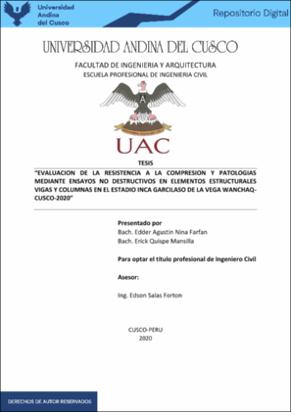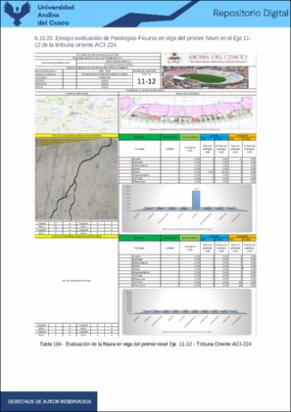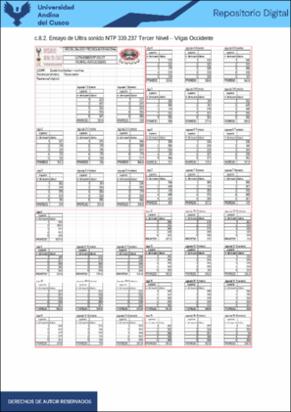| dc.contributor.advisor | Salas Fortón, Edson Julio | |
| dc.contributor.author | Nina Farfan, Edder Agustin | |
| dc.contributor.author | Quispe Mansilla, Erick | |
| dc.date.accessioned | 2021-10-26T01:48:49Z | |
| dc.date.available | 2021-10-26T01:48:49Z | |
| dc.date.issued | 2021-06-17 | |
| dc.identifier.uri | https://hdl.handle.net/20.500.12557/4210 | |
| dc.description.abstract | Resumen
El consiguiente trabajo de investigación tuvo implícitamente en el estudio de la resistencia a la
compresión en el concreto de una estructura y la presencia de patologías en el concreto mediante
ensayos no destructivos como son esclerometria y ultra-sonido, en estructuras tales cuales son
vigas y columnas, el lugar de estudio es el estadio Inca Garcilaso de la Vega en sus tribunas
oriente y occidente, Identificando primero la zona de estudio como en la tribuna oriente
teniendo 4 niveles, 2 anillos uno interior y el otro exterior con un total de 108 columnas y en
vigas un total de 219 vigas repartidos transversalmente, externos e internos. En cambio, la
tribuna occidente cuenta un total de 5 niveles, 2 anillos uno interior y el otro exterior con un
total de 158 columnas y 365 vigas repartidos transversalmente, externos e internos. Asimismo,
el diseño del concreto para estos elementos estructurales es de 210 kg/cm2, iniciando la
evaluación de la resistencia a compresión con el ensayo de esclerómetro o martillo rebote se
identifica la baja calidad de la resistencia a la compresión del concreto en el primer nivel de
la tribuna oriente identificando en las columnas, en el primer nivel, el eje interior 8 con 180
kg/cm2, en el nivel 2 exterior los ejes y en los ejes interiores) entre (130-190 kg/cm2 en ese
rango aproximadamente) tienen baja resistencia a la compresión a la de diseño y en las demás
columnas la resistencia a la compresión cumplen con la resistencia a la diseño , en cuanto a
las patologías se encontró en todo el primer nivel con un grado de severidad moderada , el
tipo de patología es debido a la abrasión y factores ambientales. En cuanto a las vigas en el
primer nivel en los ejes transversales (130-190 kg/cm2 en ese rango aproximadamente)
asimismo, en las vigas interiores en los ejes la resistencia a la compresión está en un promedio
de 180-190 kg/cm2 aproximadamente, en las vigas exteriores los ejes continua la tendencia de
la resistencia a la compresión está en un promedio de 180-190 kg/cm2 aproximadamente.
Referente a las patologías en las vigas se encontró patologías en posición vertical por acción a
cargas, también se encontró patologías por abrasión (según J. Calavera). En el ensayo de ultra
sonido la velocidad de pulso varía entre un rango de 2000-3000 m/s y un tiempo de 30-60 µs y
obteniendo los mismos datos de la resistencia a la compresión en la vigas y columnas de los
ejes anteriormente mencionados. En cambio, en la tribuna occidente los ensayos de
esclerómetro la resistencia de la compresión tiene el promedio superior a los 300 kg/cm2 tanto
en vigas y columnas de todos los ejes ya sea interior y exterior, en la velocidad de pulso un
rango superior a los 300m/s con una velocidad de 60 µs, en cuanto a patologías existe en menor
cantidad, pero en el nivel 4. | es_PE |
| dc.description.abstract | In this research work, the resistance to compression in concrete and the presence of pathologies
in concrete were studied by means of non-destructive tests such as sclerometry and ultra-sound,
in structures such as beams and columns, The place of study is the Inca Garcilaso de la Vega
stadium in its east and west stands. First, the study area is identified as the east stand, which
has four levels, two rings, one inside and the other outside, with a total of 108 columns and a
total of 219 beams distributed transversely, inside and outside. On the other hand, the west stand
has a total of 5 levels, 2 rings, one inner and one outer, with a total of 158 columns and 365
beams distributed transversally, both outer and inner. Likewise, the design of the concrete for
these structural elements is 210 kg/cm2, starting with the evaluation of the resistance to
compression with the sclerometer or rebound hammer test (ASTM C-805), the low quality of
the resistance to compression of the concrete is identified in the first level of the east tribune,
identifying in the columns, in the first level, the interior axis 8 with 180 kg/cm2, in the level 2
exterior the axes (6, 7,8,9,10,11,12,14) and in the interior axes (9,10,11,12) between (130-190
kg/cm2 in that range approximately) they have low resistance to the compression to the one of
design and in the other columns the resistance to the compression fulfills the resistance to the
design, as far as the pathologies were found in all the first level with a degree of moderate
severity, the type of pathology is due to the abrasion and environmental factors. As for the
beams in the first level in the transverse (130-190 kg/cm2 in that range approximately) also, in
the interior beams in the axes) the resistance to compression is in an average of approximately
180-190 kg/cm2, in the external beams the axes continue the trend of the resistance to
compression is in an average of approximately 180-190 kg/cm2. Regarding the pathologies in
the beams, pathologies were found in vertical position due to the action of loads, and
pathologies due to abrasion were also found (according to J. Calavera). In the ultra-sound test
(ASTM C597-NTP 339.237) the pulse speed varies between a range of 2000-3000 m/s and a
time of 30-60 µs and obtaining the same results of the resistance to compression in the beams
and columns of the previously mentioned shafts. On the other hand, in the western tribune the
evaluation of sclerometer the resistance to compression has an average of more than 300 kg/cm2
both in beams and columns of all axes both inside and outside, in the speed of pulse a range of
more than 300m/s with a speed of 60 µs, as for pathologies exists in smaller quantity, but in
level 4. | en_US |
| dc.format | application/pdf | es_PE |
| dc.language.iso | spa | es_PE |
| dc.publisher | Universidad Andina del Cusco | es_PE |
| dc.rights | info:eu-repo/semantics/openAccess | es_PE |
| dc.rights.uri | https://creativecommons.org/licenses/by-nc-nd/4.0/ | es_PE |
| dc.subject | Ensayos no destructivos | es_PE |
| dc.subject | Patologías | es_PE |
| dc.subject | Abrasión | es_PE |
| dc.subject | Resistencia a compresión | es_PE |
| dc.title | Evaluación de la resistencia a la compresión y patologías mediante ensayos no destructivos en elementos estructurales vigas y columnas en el Estadio Inca Garcilaso de la Vega Wanchaq Cusco-2020 | es_PE |
| dc.type | info:eu-repo/semantics/bachelorThesis | es_PE |
| thesis.degree.name | Ingeniero Civil | es_PE |
| thesis.degree.grantor | Universidad Andina del Cusco. Facultad de Ingeniería y Arquitectura | es_PE |
| thesis.degree.discipline | Ingeniería Civil | es_PE |
| dc.publisher.country | PE | es_PE |
| dc.subject.ocde | https://purl.org/pe-repo/ocde/ford#2.01.01 | es_PE |
| renati.advisor.dni | 23853692 | |
| renati.author.dni | 78205647 | |
| renati.author.dni | 47401755 | |
| renati.discipline | 732016 | es_PE |
| renati.juror | Gutierrez Vallejo, Heber Darwin | |
| renati.juror | Alanoca Aragon, Alain Elvis | |
| renati.juror | Chura Cortez, Cesar Augusto | |
| renati.juror | Alvarez Espinoza, Jorge | |
| renati.level | https://purl.org/pe-repo/renati/level#tituloProfesional | es_PE |
| renati.type | https://purl.org/pe-repo/renati/type#tesis | es_PE |




